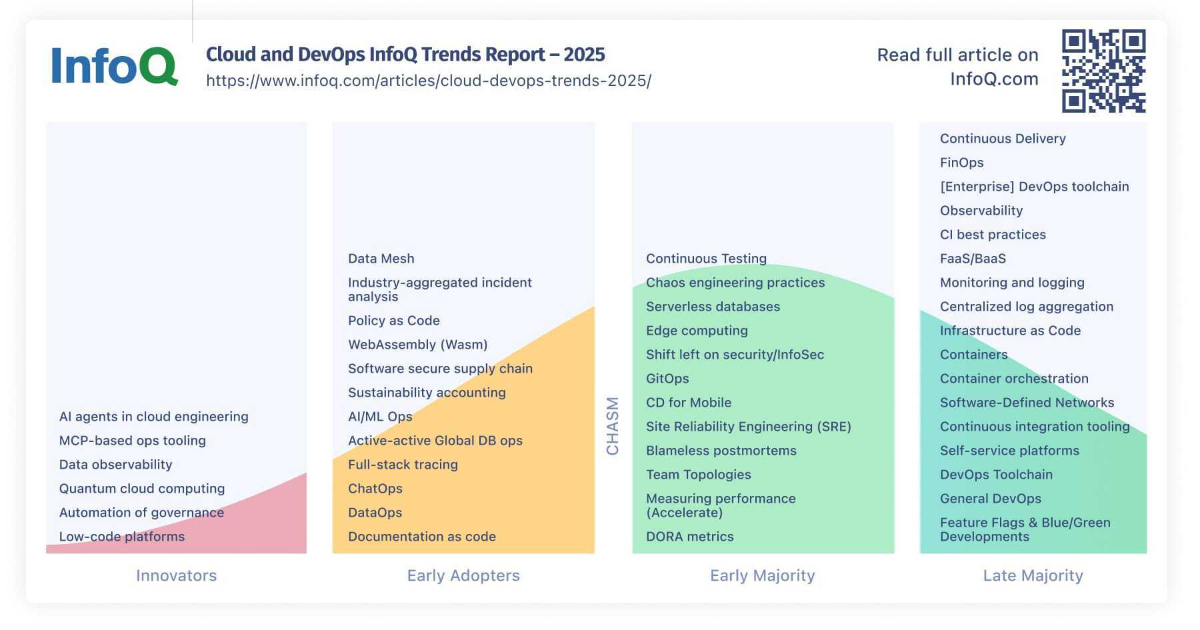Key Takeaways
- The rise of AI Agents for cloud engineering shows a lot of promise. However, enterprise adoption is slowed by compliance, security, and the need for human governance alongside legacy systems.
- Platform Engineering is a boardroom priority driven by developer experience (and ultimately, productivity). Yet, success is often limited by organizational tool fragmentation and a lack of foundational Value Stream Management.
- FinOps has matured beyond budgeting to focus intensely on cost optimization and strategic consolidation, driven by global pressure to “do more with less” and the high compute costs of AI initiatives.
- The influx of new tools and AI mandates is currently increasing cognitive load across all roles, not reducing it. Leaders must prioritize consolidation and measure value beyond “vanity metrics”.
- Kubernetes is now the stable, de facto substrate for cloud-native deployment. The stability of the Kubernetes API supports the practical reality of hybrid and multi-cloud strategies, which are in turn driven by the underlying need for resilience and digital sovereignty.
The InfoQ Trends Reports offer InfoQ readers a concise, opinionated overview of topics that we believe architects and technical leaders should prioritize. In addition to this report and the updated DevOps and Cloud InfoQ trends graph, an accompanying podcast is available, featuring several editors and friends of InfoQ discussing these trends.
An essential part of the annual trends report is the trends graph, which shows what trends and topics have made it to the innovators category and which ones have been promoted to early adopters and early majority categories. The categories are based on the book Crossing the Chasm by Geoffrey Moore. At InfoQ, we primarily focus on categories that have not yet crossed the chasm. Here is this year’s graph:

Some significant innovations and developments have occurred since the InfoQ team discussed the trends report 18 months earlier (see 2023 trends graph below).

This article highlights the trends graph, which shows different phases of technology adoption, and provides more details on individual technologies that were added or updated since last year’s trends report. We also discuss which technologies and trends have been promoted in the adoption graph.
Here are some highlights of what has changed since last year’s report:
Innovators
The first category on our adoption graph, Innovators, will see some changes heavily dominated by advanced AI automation. These changes are discussed in detail below.
AI Agents for Cloud Engineering
One area that has seen significant developments this year is the evolution of AI tools from simple chatbots to sophisticated, action-oriented AI Agents. These agents are designed to execute complex tasks and interact with cloud resources, moving beyond conversational assistance to genuinely augment engineering teams. This shift signifies a crucial advancement toward enterprise-ready AI, despite the ongoing need for human oversight and strong governance.
Steef-Jan Wiggers and Matt Saunders discussed AI Agents in this year’s podcast:
Steef-Jan Wiggers
I think, of course, the infusion of AI is predominantly in a lot of cloud services. Not sure they’re always helpful, but you definitely see an uptick of AI going from what is the first wave, now all the way to agentic, where you also see agents popping up in some of the, I would say, cloud services as well.
Matt Saunders
We are now seeing tools emerging in this space that are not just chatbots… now we’re seeing things like you mentioned, Pulumi, which launched a thing called Neo, essentially an agent for cloud engineering.
Practical, Early Automation of Governance
Innovators are also implementing AI at a practical level to enforce governance and streamline internal processes, essentially automating the roles of architects and reviewers to reduce friction and cognitive load.
Our panelists talked about implementing AI at a practical level to enforce governance in the podcast.
Shweta Vohra
For example, if I want to enforce a checklist for my engineers, I can automate it now. Earlier, it was about explaining everything to everyone… but now I have the chance to include it in my pipelines, introduce some AI, and see if they can proceed or not.
Model Context Protocol (MCP)
Introduced by Anthropic in November 2024, MCP is an open standard designed to help frontier LLMs produce better and more relevant responses. It provides a standardized protocol for integrating and sharing data between external tools, systems, and data sources with the LLMs, effectively eliminating the need for fragmented and custom integrations. Major players like OpenAI, Microsoft, and Google have announced plans to integrate MCP support into their products.
The panelists discussed the role MCP is going to play in Cloud and DevOps.
Matt Saunders
I’m anticipating an MCP apocalypse in the next year or so. Where we are, everyone’s adopting MCP, the standard is settling down, and we’re resolving all these issues about how to give granular access to an MCP server. I see us coming in, with our DevOps and cloud knowledge of automating processes and using infrastructure as code, as a significant contributor to solving that, so that we can give AIs access to things in the right ways. I think there’s a lot of DevOps learning that we could use in there.
Early Adopters
In the Early Adopters category, we would like to highlight: Platform Engineering Teams, Cross-cloud/Cloud-native hybrid approaches, and developer experience frameworks.
Platform Engineering Maturity
While the concept of Platform Engineering has evolved, organizations are going beyond tool aggregation to build internal development platforms (IDPs) that treat the platform itself as a product with measurable outcomes. Yet truly cohesive ‘platform as a product’ implementations are rare; success depends on value-stream thinking, clear team boundaries, and reducing tool fragmentation.
Shweta Vohra:
I have not yet seen a successful platform as a product. A fully formed product is something I know many people support building. Let’s build it as a platform as a product. The reason is that I’m telling you the ground realities I have seen, but things are still being built in isolation, leading to tool fragmentation. Of course, different teams own different sets of tools and create in isolation, but when they do, the glue is always a problem. When you are just putting the puzzle pieces one on top of the other without a proper fixture, of course, none of the puzzles can be fixed the right way.
In platform engineering as a practice, I’ve seen it gaining adoption and reaching some maturity, with everyone talking about the developer experience. Whether you take one step or many steps depends on the company’s culture, which many teams are adopting. Platform engineering is definitely a buzzword on a keyboard. Some places are really doing their job by bringing the focus we need, making management manageable, or providing the glue where isolation can make sense, and we carry a bit more glue to that.
Cross-cloud/Cloud-native hybrid approaches
Early Adopters are not just using multiple clouds; they are embracing a strategic hybrid and multi-cloud approach driven by external constraints like compliance and sovereignty. Their goal is not just cloud adoption, but ensuring business continuity and legal adherence across diverse geographies.
The cloud landscape is broadening under digital sovereignty. Beyond the ‘big three’, regional providers are emerging; Kubernetes is the de facto substrate, and hybrid/multi-cloud is the practical default for latency, compliance, and disaster recovery.
Steef-Jan Wiggers
At QCon London, I saw a talk about hybrid cloud in retail. Your warehouse system is not something you want to have connected online because you always want to do your order picking. From that perspective, you will see things running on-prem but also in the cloud when it comes to IoT or Edge. You still have devices accumulating telemetry and push that out for your data platform.
Back in the day, when cloud computing came, it was like, “Yes, we’re going all the way into the cloud.” But that never came to fruition because, in my day-to-day job, let’s say 80% was always hybrid, with maybe 10% or 20% when I was dealing with a completely SaaS solution exchanging data. Sure, CRM, Salesforce, with another SaaS cloud that uses platform services. Yes, completely Cloud, I would say, where you do a native solution at an insurance company, as I’ve done. But most of the time, it’s hybrid connectivity with on-prem systems.
When you go to industries, you receive your purchase or production order, which is sent to a factory, essentially a machine that’s not connected online. So it comes in, gets validated, and is fed into the machine that prioritizes, does the job, and then reports back. Maybe I’ve used this amount of ink, let’s say you’re printing ink labels or anything, and then report that back to the EAP. That’s an entirely hybrid solution and will remain so because the machine will not go to the cloud. You still need to feed that with specific orders, and then it can prioritize based on what you do on-prem, and then it does it. But yes, hybrid is still there. Yes, it’s not going away at all. When there’s, for instance, [the need for] low latency, then you’re completely on-prem. You’re not using the cloud at all.
Shweta Vohra
Yes, I think hybrid cloud is a reality. You rightly said it, Steef. I mean, it’s not going anywhere. I dabbled with many hybrid cloud customers working for IBM, Accenture, and other companies, where this approach benefits numerous others. I still noticed that we have mainframes, which are much stronger than any of their cloud offerings. Hybrid cloud is a reality. Multi-cloud, I’ve seen that people… There is not much fuss nowadays. I’ve heard about whether you should be vendor locking or going with multi-cloud. That disturbance, I don’t see. Trend-wise, if I may call it that, people are opting for one cloud provider as the base and then topping it up with various services from others.
For example, if I’m going with AWS, I’ll use Gemini or other things from Google, as well as other services I may need. Multi-cloud-wise, at least in my experience, I haven’t seen those articles or trends popping up again, questioning whether we should still be going. In terms of strategy, one thing I’ve noticed working well compared to others trying to go all cloud is that if you focus on your major workload, it’s like the 80/20 rule. Pick those 20% that have 80% of impact. If you can move them, your organization is there. I think leadership can try to focus on those things. Once that needle moves, rest becomes easier for your business. Those are the things I have noticed.
Developer Experience (DevEx) Frameworks
The massive financial commitment to tools that measure and improve developer efficiency indicates that frameworks for quantifying Developer Experience (DevEx) are in the early adopter category. This is seen as a critical innovation for linking engineering effort directly to business value.
Daniel Bryant and Matt Saunders’ discussion noted the significant news of DX being acquired by Atlassian for a billion dollars.
Matt Saunders
We all know that the number of lines of code written is not a good way to determine if your developers are productive, nor should it be used in those stereotypical methods of poorly measuring developer productivity. But the sheer intent of these significant acquisitions suggests that we’re going to see quite a lot of this in the future. Whether it’s an AI play or not, I don’t know. It’s too early. I work in the Atlassian ecosystem, but I’ve only got a day’s notice of this as well. As these elements come together, you can envisage deep integration with wikis and ticketing systems to work out what people are actually doing. It’s going to be quite interesting to see what products and add-ons we get.
Early Majority
We are moving the following topics to the Early Majority category, as these technologies have become more mature and widely adopted by software development teams in various organizations.
- Focus on developer experience
- Service Mesh and eBPF
- Continuous Testing
Late Majority
The last category in our adoption graph, the Late Majority category, has also seen some new additions as these technologies are now fully adopted by teams and are part of their core architecture patterns.
- FinOps
- Enterprise DevOps Toolchain
- Observability
Conclusion
The maturing of FinOps, observability, and the enterprise DevOps toolchain into the Late Majority phase marks an important inflection point for the cloud and DevOps ecosystem. The foundations are now stable: teams have standardized on cloud-native infrastructure, embraced automation as default, and normalized continuous delivery practices.
Yet this very maturity exposes a new set of challenges. The fragmentation of tools and responsibilities across organizations has led to cognitive overload and diminishing returns. Many leaders are discovering that the next wave of progress will come not from adopting more tools, but from integrating and governing the ones already in place.
At the same time, the emergence of AI agents and standards like the Model Context Protocol (MCP) signals the start of a new operational paradigm, one where automation becomes increasingly autonomous, but never entirely independent of human judgment. The ability to blend AI-driven execution with clear guardrails and platform governance will determine whether these technologies amplify or undermine productivity.
Meanwhile, digital sovereignty and sustainability concerns continue to pull infrastructure decisions back toward hybrid and multi-cloud realities. These constraints are forcing a renewed emphasis on resilience, cost optimization, and data control, reinforcing the importance of FinOps and platform engineering as strategic, rather than tactical, disciplines.
In short, the DevOps movement is entering its next phase not with disruption, but with deliberate consolidation. The winners in this new phase will be those who align platform engineering, AI-enabled automation, and human-centric governance into a cohesive value stream, turning efficiency into flow, and complexity into clarity.







